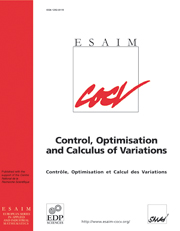Article contents
The brachistochrone problem with frictional forces
Published online by Cambridge University Press: 15 August 2002
Abstract
In this paper we show the existence of the solution for the classical brachistochrone problem under the action of a conservative field in presence of frictional forces. Assuming that the frictional forces and the potential grow at most linearly, we prove the existence of a minimizer on the travel time between any two given points, whenever the initial velocity is great enough. We also prove the uniqueness of the minimizer whenever the given points are sufficiently close.
- Type
- Research Article
- Information
- Copyright
- © EDP Sciences, SMAI, 2000
References
H. Brezis, Analyse fonctionnelle. Masson, Paris (1983).
Giannoni, F., Piccione, P. and Verderesi, J.A., An approach to the relativistic brachistochrone problem by sub-Riemannian geometry.
J. Math. Phys
. 38 (1997) 6367-6381.
CrossRef
Giannoni, F. and Piccione, P., An existence theory for relativistic brachistochrones in stationary space-times.
J. Math. Phys
. 39 (1998) 6137-6152.
CrossRef
L.A. Pars, An Introduction to the Calculus of Variations. Heinemann, London (1962).
Perlick, V., The brachistochrone problem in a stationary space-time.
J. Math. Phys.
32 (1991) 3148-3157.
CrossRef
- 2
- Cited by




